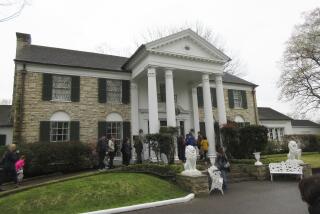Venice history by way of Africa
“A local paper ran a story, and the headline said something like ‘The American Pavilion Is for Venice,’ ” says Fred Wilson, smiling as he stands at the entry to the American Pavilion for the 50th Venice Biennale. “That’s perfect.” The artist insists he wanted his pavilion project to be understood as an engagement with the city rather than an attack -- and he has reason to sweat the distinction. The pavilion at the world’s largest contemporary art festival is indeed devoted to Venice, but it isn’t a romantic waxing on the City of Doges. Rather, it offers a humor-laced, sometimes harshly illuminating tour through the racial dynamics of the centuries-old hub of trade, tourism, art, politics and religion -- in other words, the perfect place to pose questions about race and representation.
“It’s not just criticism,” says Kathleen Goncharov, curator of public art at the MIT List Visual Arts Center and Wilson’s other half in the artist-commissioner structure established for the pavilion. “It’s thoughtful critique.
“One of Fred’s strengths as an artist is his drive to involve himself in the community where he’s working,” she adds. “This project was never about attacking Venice or Italy or Europe. It’s about examining and interpreting the history of the Venetian Republic and understanding Europe as a complex and rich place. What Fred sees in Venice is a Europe that is rich, in part because of a diversity too seldom conveyed in the field of art history.”
Though far from American cultural institutions where his rearranged displays of art and artifacts have brought notoriety and a 1999 MacArthur “genius” award, Wilson remains in familiar territory. In fact, his Venice project has much in common with some of his earliest activities. In 1987, as director of the Longwood Art Center in the Bronx, he displayed works by emerging artists as if they were “primitive” artifacts from non-Western cultures. His first solo show at New York’s White Columns in 1990 re-created a natural history exhibit but with labels noting that the bones on view belonged to individuals with lives and identities before they became specimens.
Two years later, Wilson confronted visitors to Baltimore’s Maryland Historical Society with reconfigured exhibits that raised humorous and biting questions about the story of race in America.
“The project Fred produced for Venice is quite consistent with his other work,” says Maurice Berger, curator for the Center for Art and Visual Culture at the University of Maryland. Berger is as familiar with Wilson’s output as anyone, having organized the current survey exhibition “Fred Wilson: Objects and Installations, 1979-2000.” “This is not cool conceptual work,” he argues, “nor is it single-issue work. It is broadly resonant and emotionally powerful. It addresses loss and absence, and it brings out many different strong reactions from viewers.”
Seeing what ‘tends to go unseen’
Describing himself as of “African, American Indian, European and Amerindian” descent, Wilson, 48, is well versed in the complexities his work probes. Growing up both in his birthplace of the Bronx and in a white suburban tract of Westchester County, he took classes at the Metropolitan Museum of Art and attended the racially diverse High School of Music and Art in Manhattan. He later studied at the State University of New York at Purchase, where he was the only black student in his program. These experiences, combined with that of navigating a segregated art world in the ‘80s, left him with an awareness that fuels his art.
“You just have to be aware,” he insists. “The material I work with is all around, but it tends to go unseen. I’m aware, and I see it.”
Wilson’s elaborate Venice installation, “Speak of Me as I Am,” which borrows its title from a line in “Othello,” is all about seeing what might go unseen and seeing differently when it comes to how Africans figure into Venetian culture. “I had no shortage of material to work with,” Wilson says.
His claim is backed by art historians Paul H.D. Kaplan and Salah Hassan, whose essays in the American Pavilion catalog tell of a Venice filled with varied representations of Africans. They range from personifications of virtue to those of sin, and from delicate portrayals to caricatures. Dating from the 11th century to the present, they span shifting cultural attitudes from before, during and after the Atlantic slave trade.
The images also reveal assorted European preoccupations, from the convention of portraying one of the three Magi as black, to the 14th century celebrity of Ethiopia’s Christian emperor Prester John, to the African servants common in paintings of feasts. And then there’s the fascination with Moors, so powerful that Venetian shops still make steady sales of “Moor’s head” jewelry while brown things, from bronze statues to chocolate candies, warrant brand names and slang references including the word “Moor.”
So abundant in such representations is Venice that Wilson wanted to do a project there before the American Pavilion ever came up, and he made a research pilgrimage to the city with Goncharov in 2001. She submitted Wilson’s name to the Fund for U.S. Artists at International Festivals and Exhibitions, and they learned of their selection just last October, leaving them with under nine months to generate the project.
The show is nothing short of ambitious. Consisting of what the artist describes as an ensemble of individual works presented together as one, it includes among its stronger points a massive entryway chandelier made entirely of jet-black Murano glass that has, when caught in the right light, a haunting cast of crimson. Other pieces mix black African figurines with stark replicas of bleached classical statues, among them a Sambo-like figure holding aloft two severed white hands before an armless torso.
Wilson, who remembers being curious about African figures he saw in European paintings at the Metropolitan Museum as a youth, professes a similar fascination with trying to understand who African Venetians are, whether in centuries-old art or in the present day. The preoccupation shows in the pavilion’s wall of photos, some of historical paintings depicting Africans and others showing contemporary African immigrants going about life in Venice.
Wilson’s interest is more provocatively reiterated in the pavilion’s display window, which is not unlike that of a department store and which the artist has filled with custom-made and costumed mannequins based on black figures found in paintings around Venice. In front of the window sits a Senegalese street vendor employed by Wilson to offer, as African vendors can be found doing elsewhere in the city, an inventory of knock-off handbags, here made of fabrics with Venetian-esque patterns designed by Wilson.
The most telling part of the whole show is the entrance, where two large banners bear images depicting statues of Africans, who appear to be holding up the temple-like pediment of the neoclassical pavilion. Though the actual figures can be found at a Venetian tomb, here they also refer to the likes of Michelangelo’s slaves and the caryatids that similarly hold up a porch of the Erechtheion in Athens. African, American, Venetian, the Neoclassical, the Greco-Roman tradition, the contemporary: Here at the doorway is where it comes together and where one sees what a complicated world Wilson opens up.
Meanwhile, Wilson, who doesn’t seem to be much of one for taking breathers, is opening up plenty of complexities back on American soil. He is already in planning for projects at the Fabric Workshop in Philadelphia and the Aldrich Museum in Ridgefield, Conn. The survey Berger organized, amid its national tour, has coming stops at the Phillips Academy in Andover, Mass., the Studio Museum in Harlem and the Chicago Cultural Center. Angelenos will get their chance to view the survey when it comes to the Santa Monica Museum of Art from Dec. 5 to Feb. 8.
More to Read
The biggest entertainment stories
Get our big stories about Hollywood, film, television, music, arts, culture and more right in your inbox as soon as they publish.
You may occasionally receive promotional content from the Los Angeles Times.






